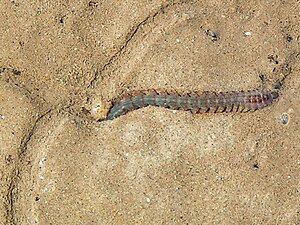Iridescent ringworm
| Iridescent ringworm | ||||||||||||
|---|---|---|---|---|---|---|---|---|---|---|---|---|

Iridescent ringworm ( Hediste diversicolor ) |
||||||||||||
| Systematics | ||||||||||||
|
||||||||||||
| Scientific name | ||||||||||||
| Hediste diversicolor | ||||||||||||
| OV Müller , 1776 |
The Iridescent ragworm ( Hediste diversicolor , synonym : Nereis diversicolor ) is a marine annelid of the genus Hediste within the polychaete - Family of Nereididae .
features
The iridescent ringworm has a long and narrow body that tapers towards the back. It becomes up to 20 cm long and then has about 120 segments . The prostomium carries a pair of short antennae without antenna supports, a pair of two-part palps that are longer than the antennae, and two pairs of eyes arranged in a trapezoid. The dorsal tentacles - cirrus are longer than the ventral ones, and the second dorsal tentacle cirrus extends to the third bristle-bearing segment. The pharynx has a pair of toothed jaws, each with 5 to 8 teeth. The mouth and maxillary rings have tooth-like, conical paragnaths.
Each segment has parapodia , which are single-branched with 3 lobes in the first two segments, whereas in the other segments they are two-branched with 4 lobes. These lobes are all quite short, with the dorsal lobe of the notopodium being wide in the anterior segments and narrowing in the posterior segments. The acicula flap of the notopodium is bilobed with a small but distinct flap over the acicula present on the parapodia of all segments. On the acicula lobe of the neuropodium, a lobe protrudes behind the bristles only in the anterior segments and is absent from around the 30th segment. The ventral lobe of the neuropodium is short. The dorsal and ventral cirrus are much shorter than the lobes of the parapodia.
The animal can have very different colors and be yellowish, greenish, orange or reddish brown with two dark vertical stripes. The iridescent ringworm is quite variable in its color. It is often yellowish, greenish or orange with reddish shades or reddish-brown with two dark vertical stripes. On the back you can clearly see the pulsating dorsal blood vessel, which is colored red by the blood pigment hemoglobin dissolved in the blood plasma .
distribution and habitat
Hediste diversicolor is common in the northern Atlantic Ocean including the North and Baltic Seas, as well as the English Channel , the Mediterranean , Black Sea and Caspian Sea .
The ringworm lives in the brackish water of the estuaries on sand and silt, where it builds branched tunnels in the seabed. He also lives in the tidal zone ( Watt ) , which is sometimes dry . The animal tolerates a low salt content down to 0.1%, but also changing salt concentrations.
Life cycle
The iridescent ringworm is believed to live to be around 3 years old. It is separated from the sexes, with females and males of roughly equal size, with the number of females often predominating. Sexually mature males are light green, while the females are dark green. At sexual maturity there is no free-swimming stage other than epitoke. Groups of females can loop around a male lying on the sediment during the mating season, but fertilization takes place in the open sea water, where both egg cells and sperm are released. After mating, both males and females die. After fertilization, larvae emerge from the eggs, which, according to the current state of knowledge, always develop benthically on the sea floor step by step into crawling worms.
nutrition
Hediste diversicolor is an omnivore that eats various materials of plant and animal origin from the sediment. But it can also build a slimy funnel with which food particles from detritus or plankton are filtered from the ocean current .
Predators
The ringworm is an important food for fish and sea birds .
Use by humans
The large nereids Alitta virens and Hediste diversicolor are particularly popular fishing lures in sea and deep sea angling . The ringworms are bred commercially on farms in England and the Netherlands . Due to their size and relatively good availability, ringworms are interesting research objects for the physiology and physiological evolution of marine invertebrates.
literature
- JD Fish, S. Fish: A Student's Guide to the Seashore. Cambridge University Press, Cambridge 2011. pp. 152f.
- PJ Hayward, JS Ryland: Handbook of the Marine Fauna of North-West Europe. Oxford University Press, Oxford 1995. pp. 208-210.
- Greg W. Rouse, Fredrik Pleijel: Polychaeta. Oxford University Press, New York 2001. ISBN 0-19-850608-2
- Andrew C. Campbell: The Kosmos Beach Guide: That lives in the sea on Europe's coasts. Franckh, Stuttgart 1987. ISBN 3-440-04355-X
- Klaus Janke, Bruno P. Kremer: Dune, beach and Wadden Sea: animals and plants on our coasts. Franckh-Kosmos, Stuttgart 1993. ISBN 3-440-06759-9
Web links
- MJ de Kluijver et al .: Nereis diversicolor OF Müller, 1776. Macrobenthos of the North Sea - Polychaeta, Marine Species Identification Portal
- Wadden Sea Protection Station: The ringworm ( Nereis diversicolor )